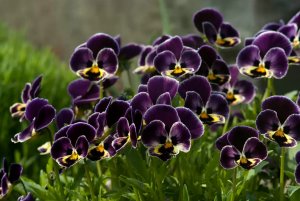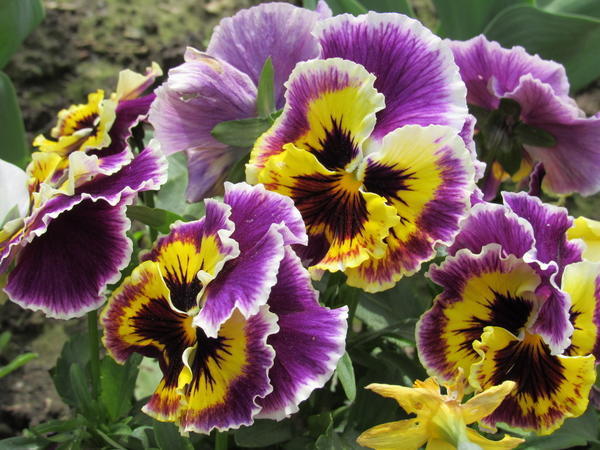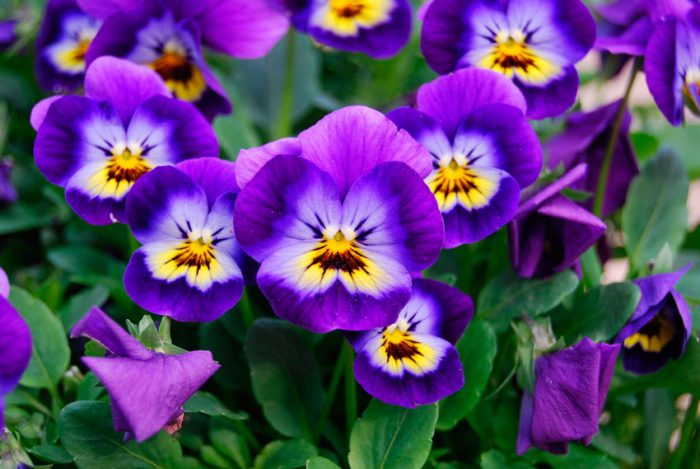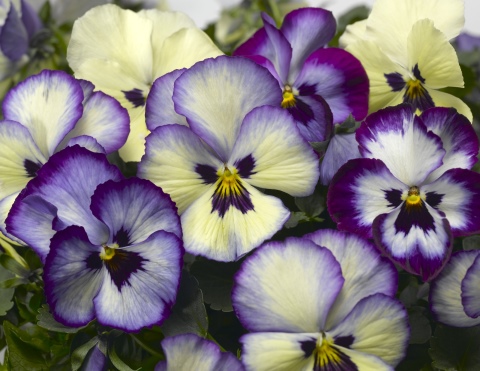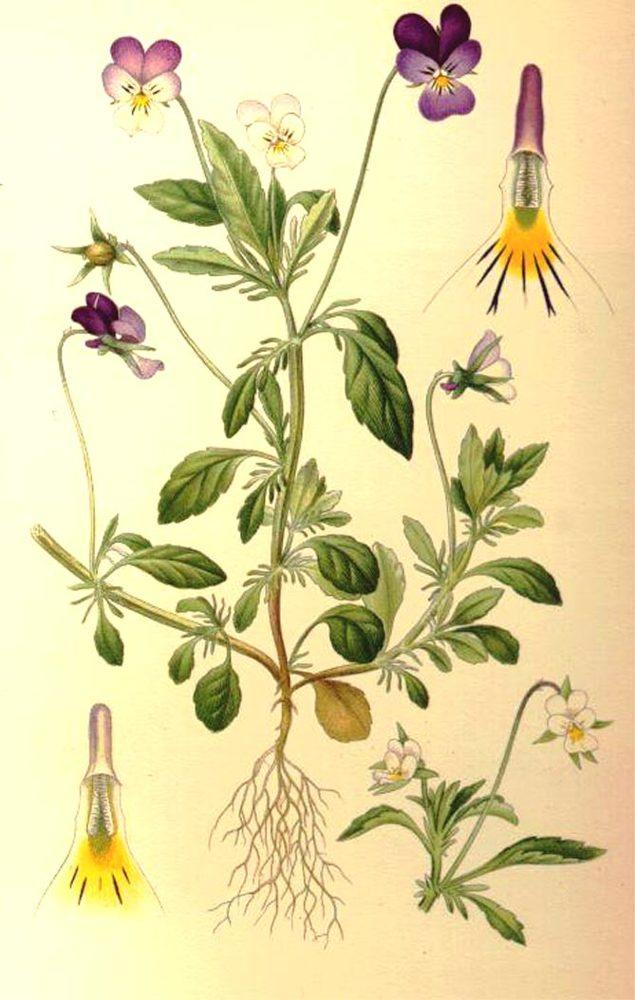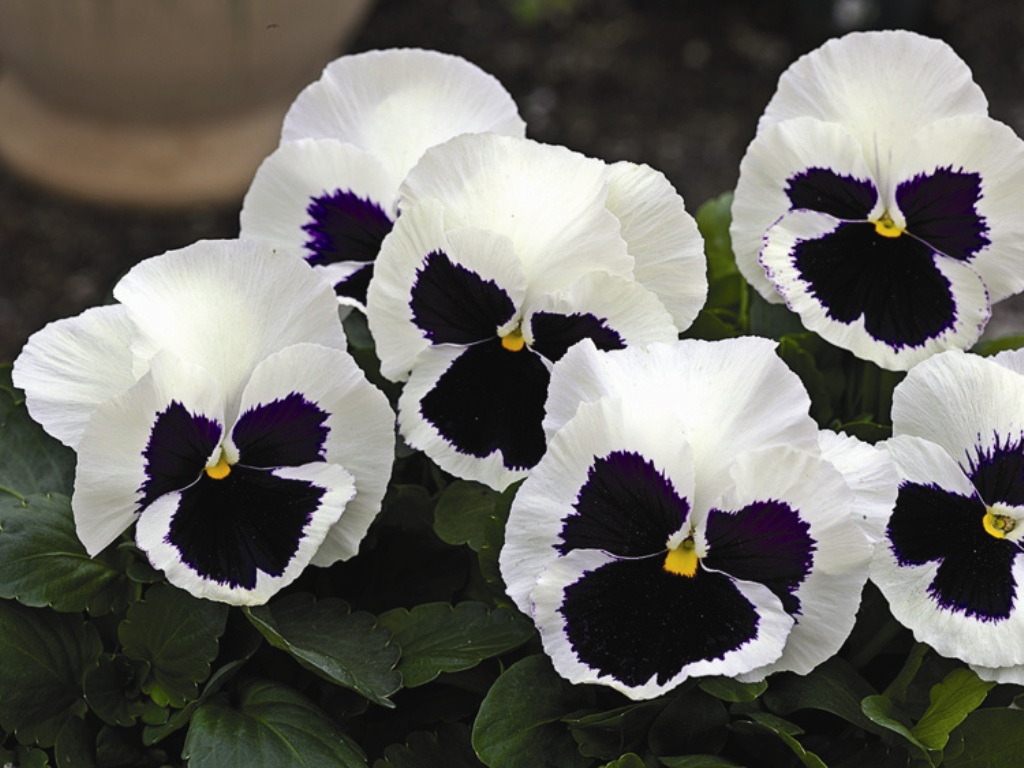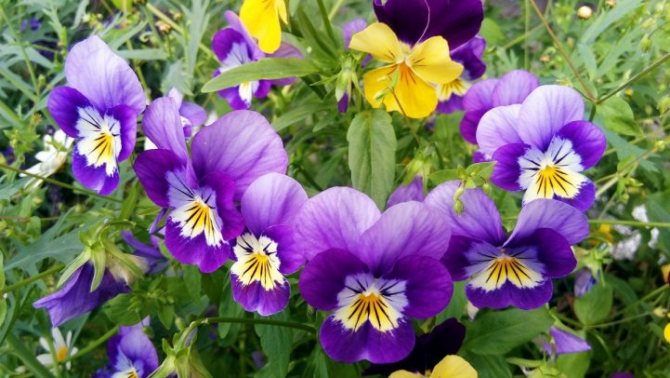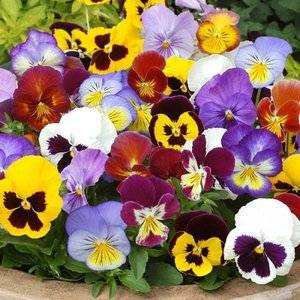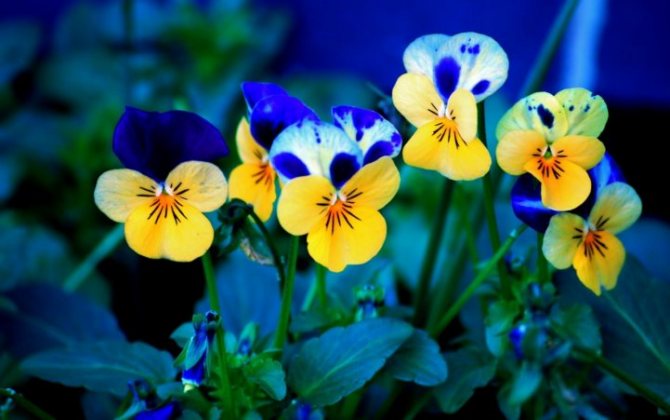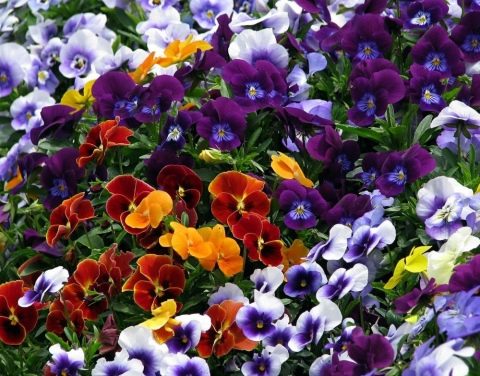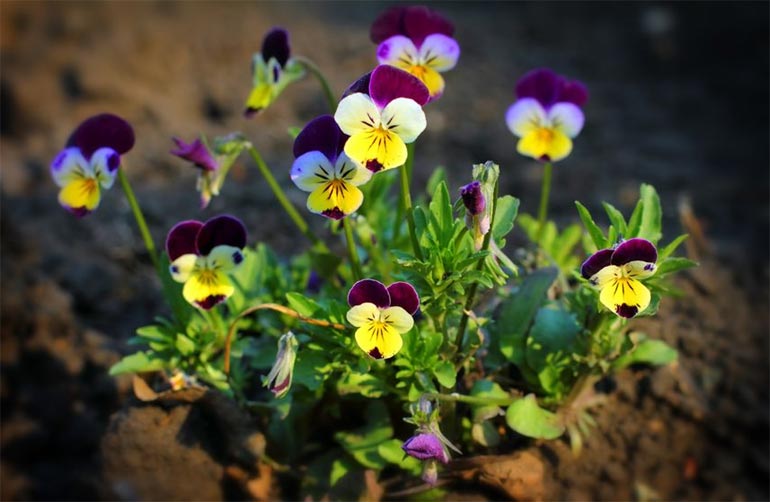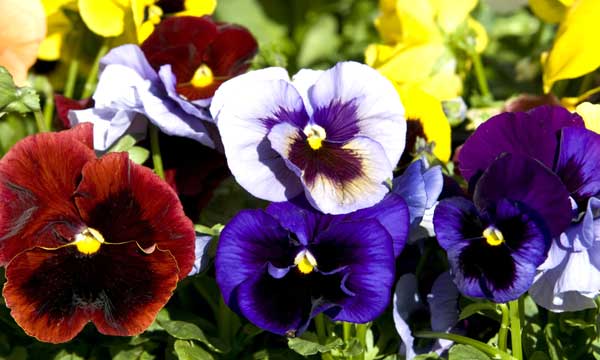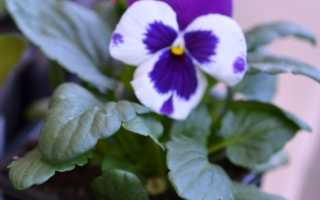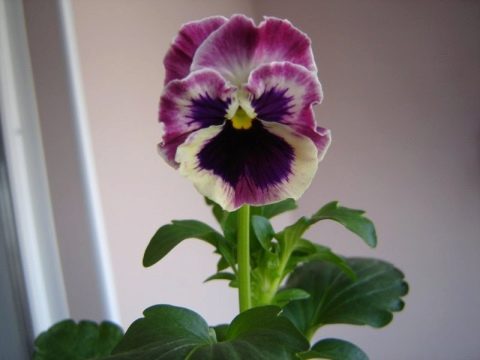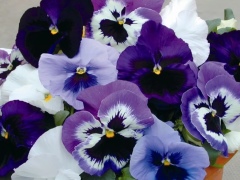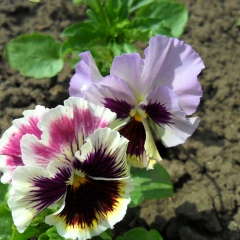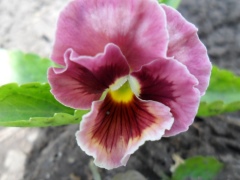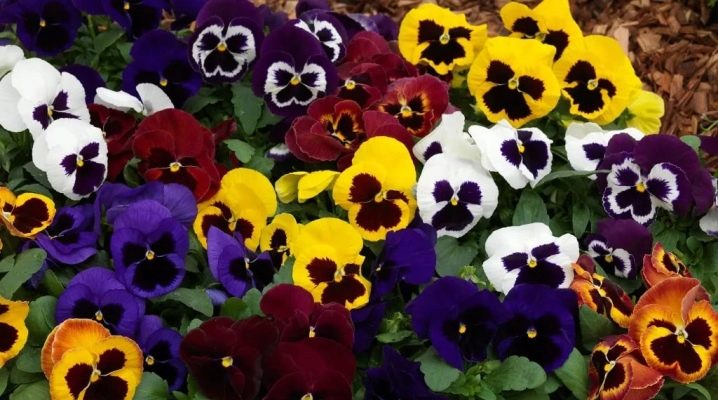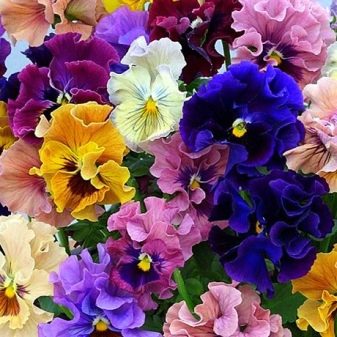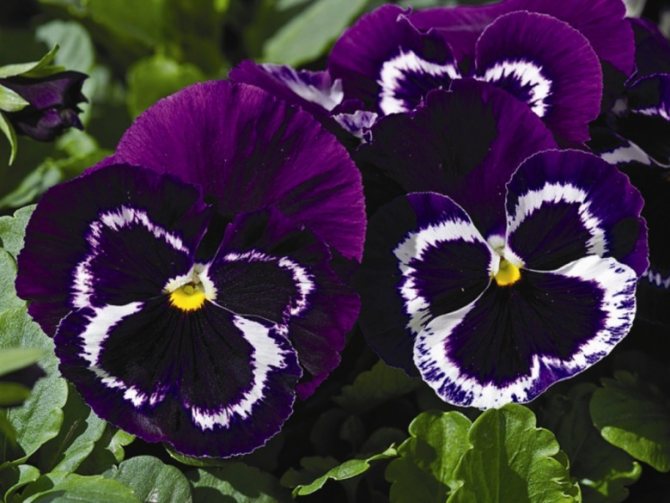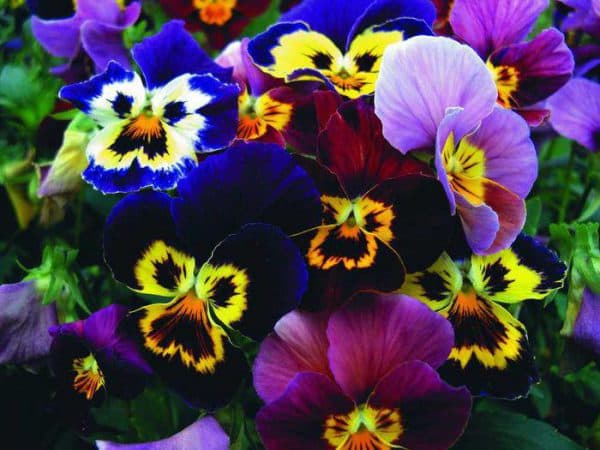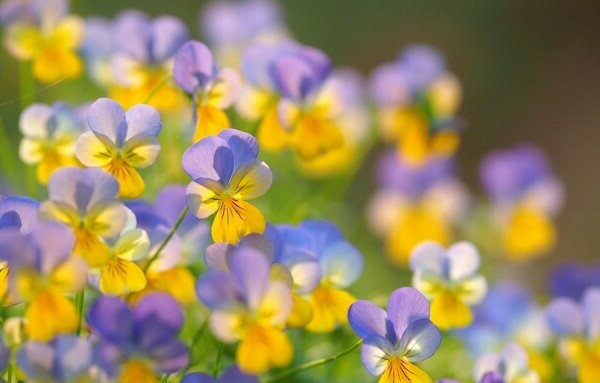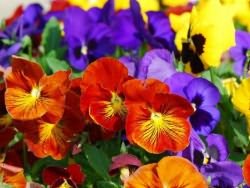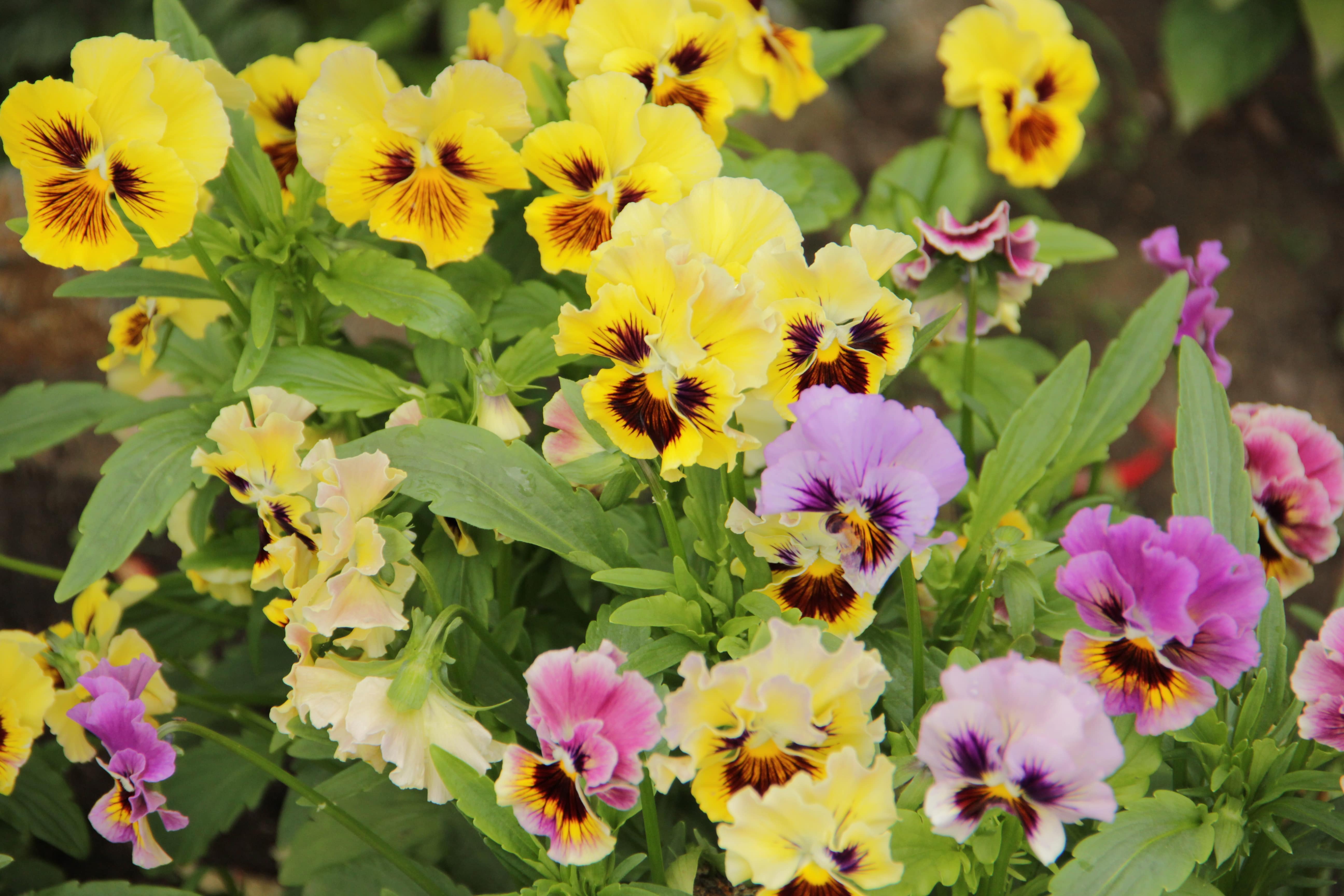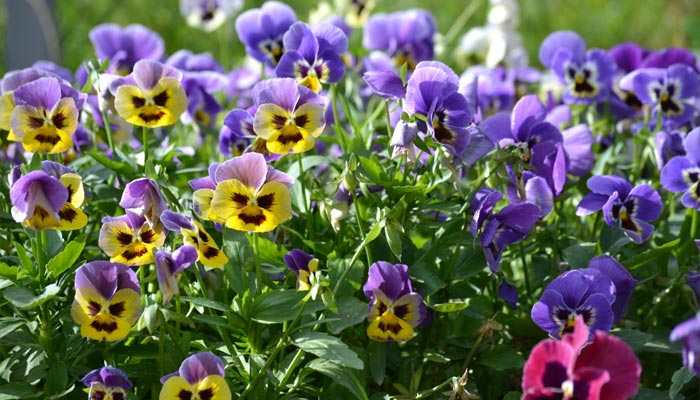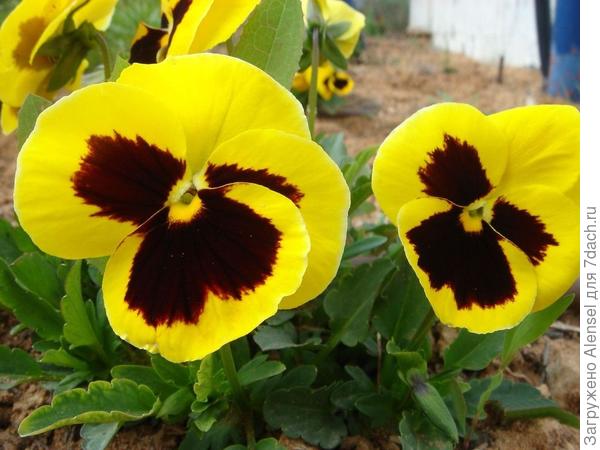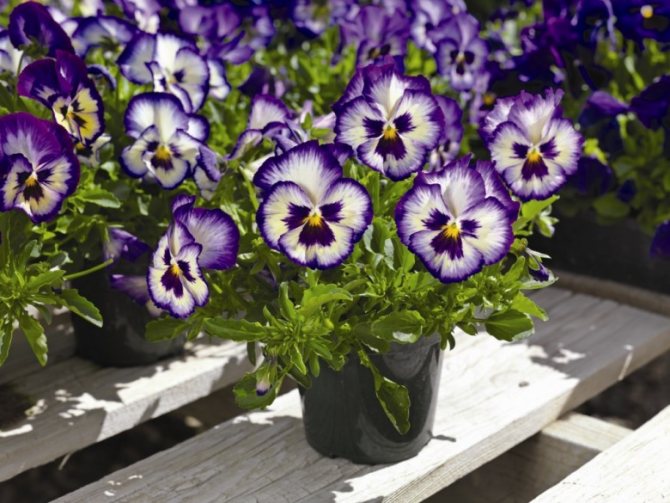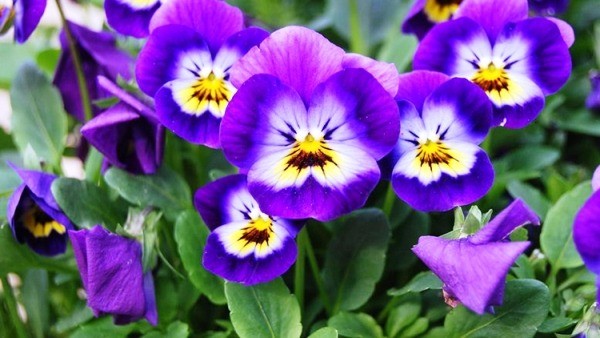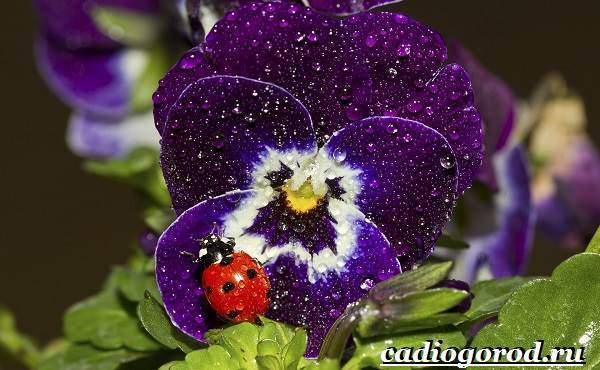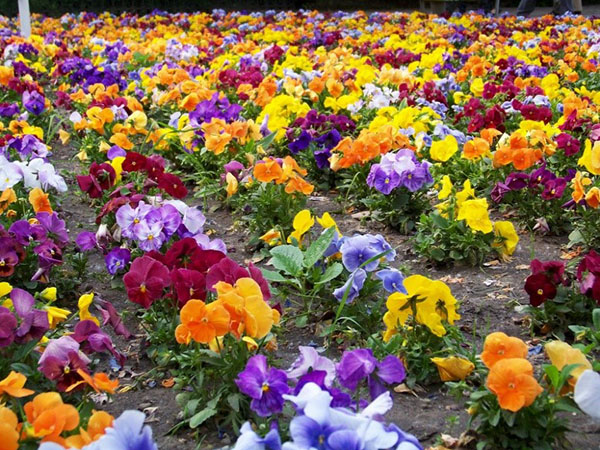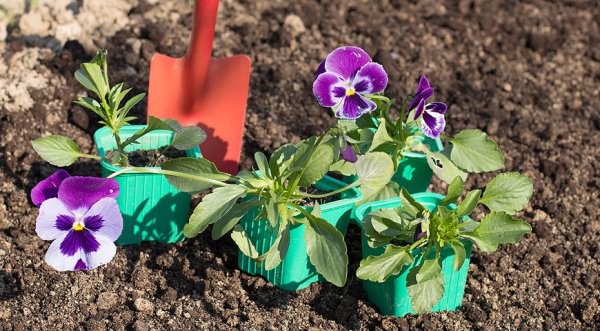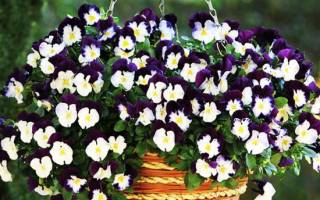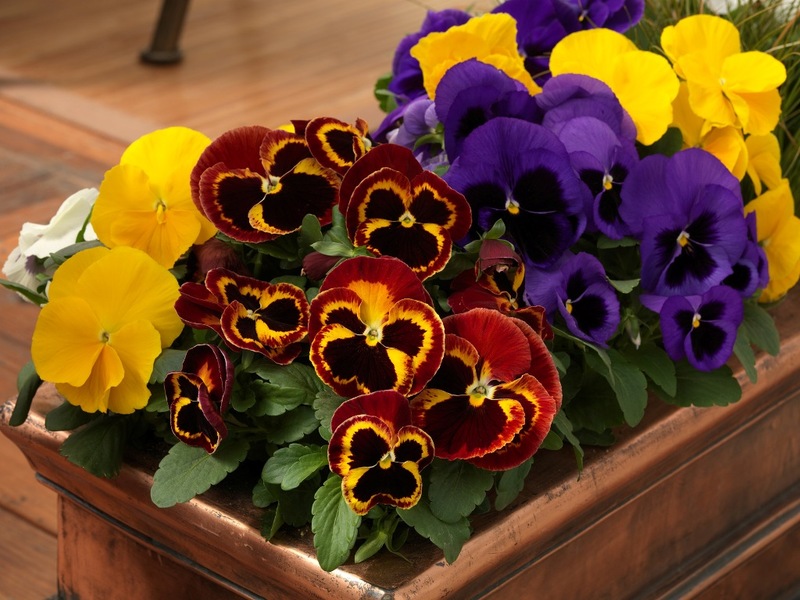Reproduction methods
Florists propagate viola in such ways.
Planting by cuttings
This method is especially important for breeding valuable varieties of viola, as it prevents the mixing of different varieties with each other. Propagating it by cuttings, you thereby rejuvenate the plant, because starting from the third year, it grows strongly, and at the same time there are fewer flowers and they are smaller. Plus, this method allows you to collect a lot of material for planting in just one season. For example, one flower is capable of producing up to 45 cuttings, and this is almost fifty future violas!
Cuttings can be carried out from May to July. Even those plants that are in the flowering phase will do. In order for the grafting process to be successful, you need to adhere to the following tips:
- First of all, you should choose a suitable place where the viola stalks will be planted. Trees are best suited for shade and moisture.
- Having decided, they dig up a small bed and water it abundantly with water.
- Following this, suitable cuttings are selected on an adult plant and carefully cut. You only need to use green apical shoots, on which two or three nodes have already formed.
- Next, the cuttings are planted on a bed, while deepening them into the ground by half a centimeter.
- The cuttings should be very tightly together, so that their leaves touch each other.
- To avoid wilting and to help take root faster, the seedlings are covered with a damp cloth (or paper).
The next few weeks, the care is not difficult - you just need to water and weed young plantings every day, and after three to four weeks your labors will begin to bear the first fruits - almost all the cuttings will take root.
If you want the viola to bloom in the same year, then cuttings should be carried out in May-June.
With later cuttings, flowering should be expected next spring. But on the other hand, it will be much more abundant than in the previous version!
Once the cuttings are rooted, they can be transplanted to a permanent growing area and taken care of. In the case of late cuttings, it is better not to transfer young plants to flower beds, but leave them to winter, covering them with foliage.
Seed propagation
This process depends on what kind of viola you want to get.
If it is an annual plant that should bloom in the same year, then the seeds should be sown in containers or greenhouses in early March. Such seedlings will bloom in June.
When grown as a biennial plant, sow immediately after the seeds are ripe. For this purpose, you also need to equip a special bed. You already know how to do this.
Seedlings will appear after two to three weeks. Two weeks later, when 2-3 true leaves appear, the seedlings need to be dived, and already in late summer - early autumn, young plants can be planted in a permanent place of growth. And already at the beginning of spring next year, you can enjoy the beautifully blooming viola.
Grow viola in your flower garden, and then a good mood and smiles will not keep you waiting!
When to plant viola on seedlings and in the ground
Sowing in the ground is practiced in June or even July. At the end of August, matured plants are transplanted from a school to a permanent place in a flower garden. For the winter, flowers are insulated with sawdust, straw, agrotechnical cloth. In spring, plants grow quickly and bloom with the arrival of heat. Florists note that with this method of cultivation, viola blooms profusely and for a long time.
The seedling method is practiced in regions with cold winters, where the plant cannot withstand frost, even under cover. The seeds are sown for seedlings in February, providing the seedlings with additional lighting.Young viola is planted in the ground at the end of May.
Dates of sowing viola seeds, depending on the region
Through seedlings, pansies are grown in the Moscow region, the Leningrad region, in the Urals and in Siberia. The seeds are immersed in the ground in February - early March. It is impossible to grow strong seedlings without increasing daylight hours to 14 hours.
Viola is planted on flower beds after the establishment of warm weather, in late May - early June. In Siberia and in the north, it is practiced to place viola in flowerpots and pots, which are placed in the garden or on the balcony. In the event of a cold snap, the flowers are carried away into the warmth.
In the middle zone of our country and in the south, you can sow pansies in the ground in mid-to-late June. In August, when the summer heat subsides, the seedlings are transplanted to a permanent place.
In the southern regions, the viola is not covered for the winter, it is enough to slightly spud the base of the bush with earth. In the middle lane, the flowers are insulated more thoroughly, covered with sawdust or shavings "with their heads". They remove the shelter in the spring, with the arrival of heat.
Favorable days for sowing viola according to the lunar calendar
| When plant viola on seedlings and into the ground in 2019 | |
| Sowing seedlings |
|
| Landing in a flower garden | May 18 or 28, June 4-6. |
| Sowing in open ground |
|
| Transfer to a permanent place | from 21 to 23 and from 26 to 28 August. |
It is undesirable to engage in sowing and transplanting plants on such days:
- February - 4, 5, 19;
- March - 6, 7, 30, 31;
- April - 5, 19, 27, 28;
- May - 5, 19, 24, 25;
- June - 3, 17, 20-22;
- July - 2, 17, 18, 19;
- August - 1, 14, 15.
Observing the above recommendations, the florist will grow healthy and beautiful flowers.
Viola care and cultivation
Garden violets are easy to grow and do not require painstaking attention, but like any vegetation they need systematic care: watering, weeding, feeding, loosening the soil.
Lighting and location
Viola is perennial, as well as one-year-old is very photophilous. For growing, it is better to choose a bright and sunny site, but at the same time it is necessary to preserve the opportunity to stay in a shaded place for several hours a day, this will not allow the bushes to dry out at high air temperatures.
Air and humidity
Pansies are moisture-loving flowers, they grow well at moderate levels of air humidity and develop comfortably in moist soil.
Priming
No special substrate is required for growing plants. Any soil is suitable for fertile and always moist. For more active and proper growth, the soil is fertilized with humus.
When to plant
The period of their flowering depends on the time of planting of Violets. To get a beautiful flowering in summer, it is necessary to take care of planting flowers in a prepared place from spring.
Usually, the seeds of perennial plants are sown in the ground before wintering. Annuals are grown in seedlings, seeds are sown in early spring, usually in March, and seedlings and seedlings are planted in May.

Outdoor cultivation
Flower bushes grow well in fertile, loose, moist soil. High-quality care in the garden is organized with the help of timely fertilization and feeding with complex mineralized solutions
Attention! Flowers do not tolerate fresh manure at all
Watering
Flowers, especially during the flowering period, need daily moisture, but excessive watering can lead to decay of the root system. Watering should be moderate as the land dries up, depending on local conditions.
Top dressing
Fertilizing the soil of the plant is necessary depending on the composition and fertility of the soil. In order for the violets to bloom as long as possible and delight with their beauty, they need 1-2 p. water with mineral solutions per month.
In no case should you fertilize flowers with organic fertilizer: manure or a cowshed.
Weeding
Pansies, very undersized bushes and weeds are their main competitors in the fight for moisture, light and nutrition.It is necessary to constantly remove all grass and weeds, then the bushes will be able to fully grow and develop.
Transfer
Plants are picked at the moment when 2 or more leaves have ripened on the branches. Usually, the pick is carried out measuredly, by seedlings, six by six. Many people emphasize in favor of a second transplant after 20 days. But this is not necessary, the main thing to remember is that the plant can be planted in the garden already matured and even flowering.
One of the uniqueness is the ability to transplant at any time, even during the flowering period. Viola takes root very well in a new place, the root system quickly adapts and practically does not wither and does not get sick during this period. It must be protected from direct sunlight and ensure abundant watering.
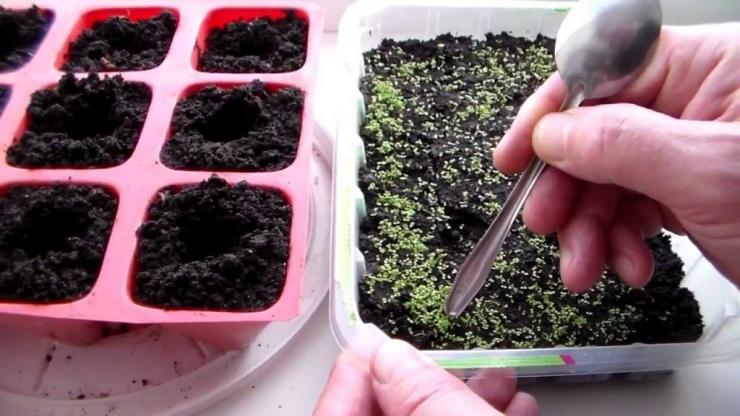
Stealing and pruning
If the bush has dried up and turned yellow, taking on a completely unpresentable look, it can be cut off, leaving 5-6 mm at the base, the first leaves from the root must be left. Resume watering and solve the problem of drying out the bush, and after 2-3 weeks the updated bush will spread its fresh green twigs and may even bloom.
Caring for Viola in the fall consists in pruning the bush when it has dried and turned yellow. The cooled 5 cm of hemp plants are covered with foliage.
Seed collection
Collecting Pansy seeds is not an easy task, but there are amateur gardeners who prefer to plant and propagate their favorite species and collect themselves. The fact is that the flower seeds are collected from the capsule, which ripens after the flowering is over. As soon as the capsule is ripe, it "shoots" and scatters the seeds around its circumference. Unripe seeds will simply remain in the soil, while ripe seeds germinate and create a beautiful carpet glade of Pansies.
To collect the seeds, you need gauze, which is tied around the heads of the fading buds, then the seeds, when the bolls are “shot”, will remain in it and will not fall into the soil.
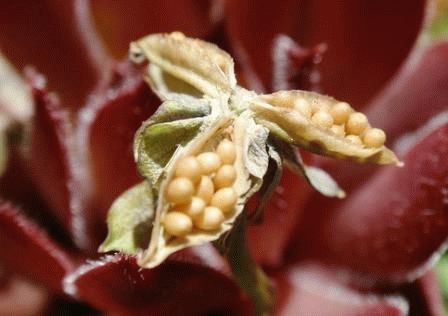
Wintering
Perennial flowers are very well adapted to winter conditions. To create more comfortable conditions for the winter time, Viola is covered with dried branches of spruce or pine and covered with foliage. With the onset of warm spring days, the shelter should be removed.

Viola Wittroca in landscaping sites
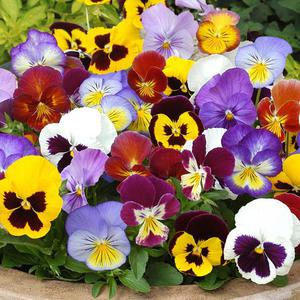 Viola has so many varieties that it can be easily used to create flower beds of different styles. Early flowering allows these plants to be widely used for spring decoration of gardens, parks, decoration of rabatki, partners, borders or flower beds. Viols are often used in leading positions in mixborders, next to stones in rockeries, on slides, in group plantings on the lawn.
Viola has so many varieties that it can be easily used to create flower beds of different styles. Early flowering allows these plants to be widely used for spring decoration of gardens, parks, decoration of rabatki, partners, borders or flower beds. Viols are often used in leading positions in mixborders, next to stones in rockeries, on slides, in group plantings on the lawn.
Very often, with their help, they form trunk circles next to trees, container compositions that are installed on windows, loggias and balconies.
We can conclude that Viola Vittroka is an incredibly beautiful flower, unpretentious to care for and simple in terms of planting, capable of decorating any interior of a park or garden. And the long duration of flowering of this plant will surely not leave indifferent any of the lovers of green pets.
Viola flower
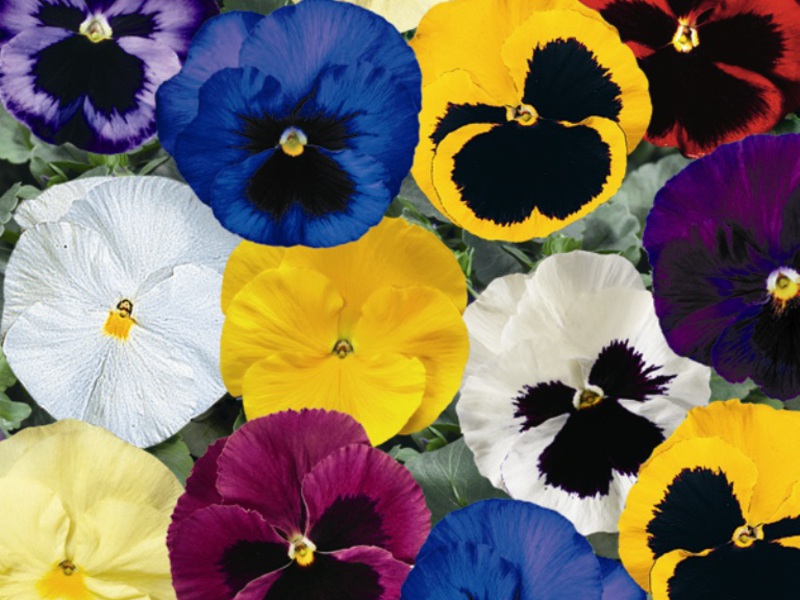

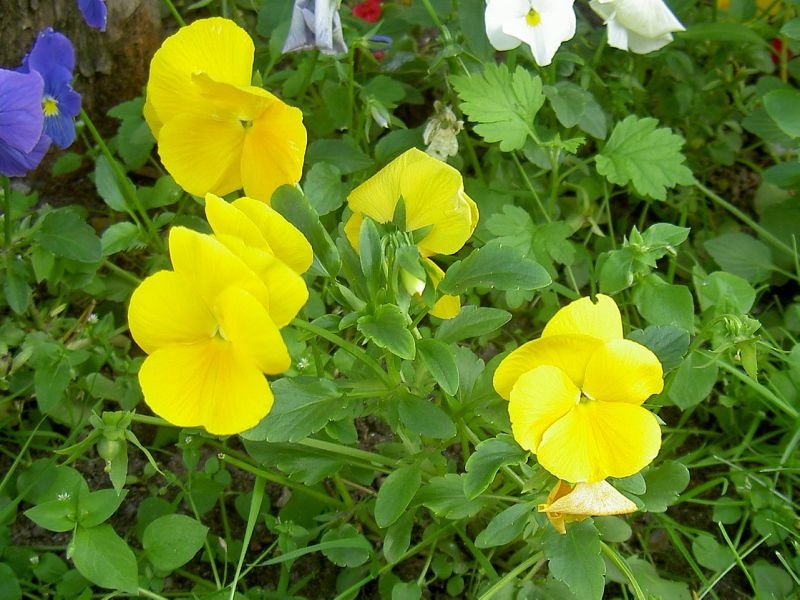
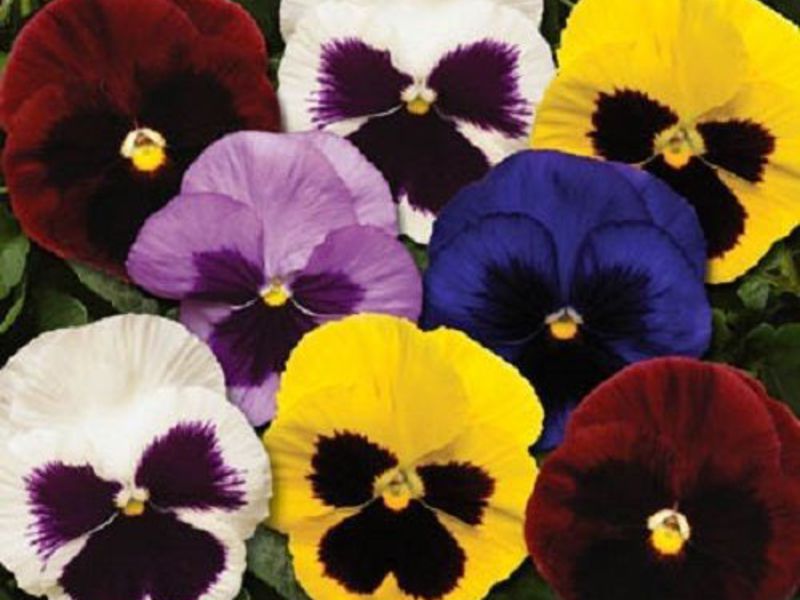
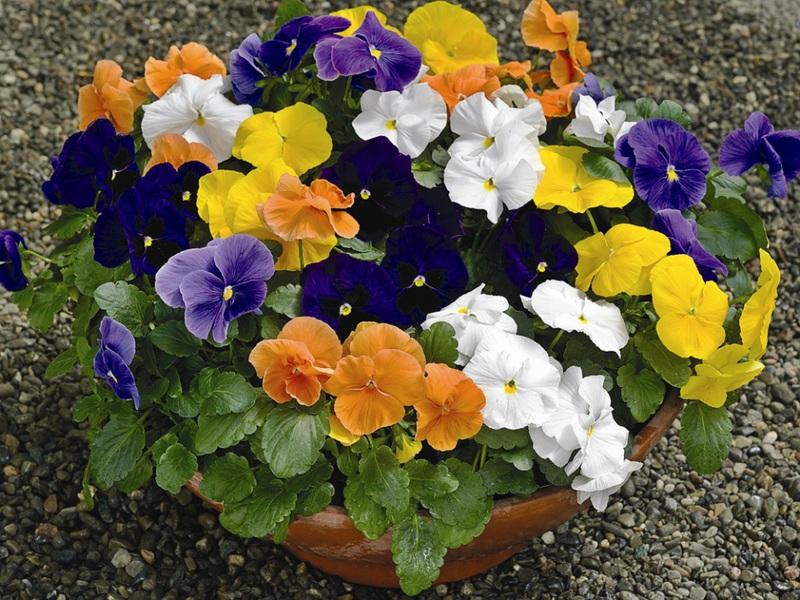

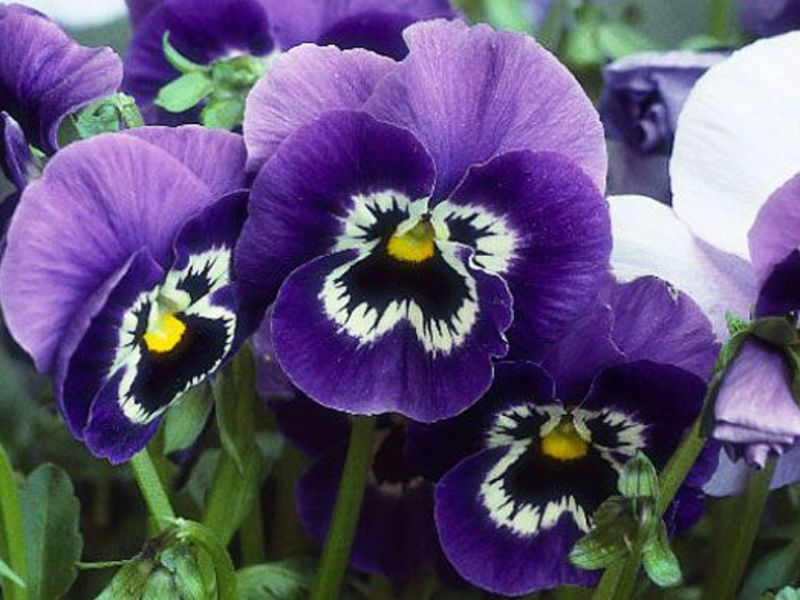
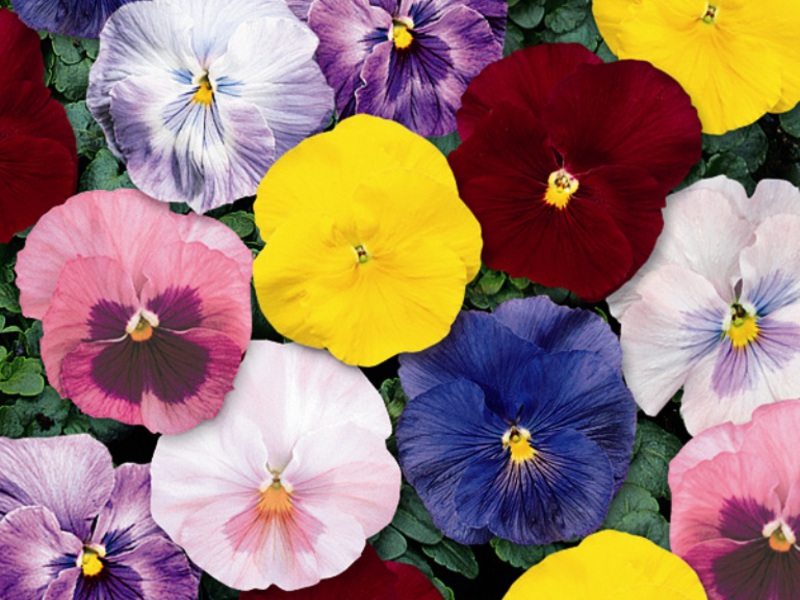
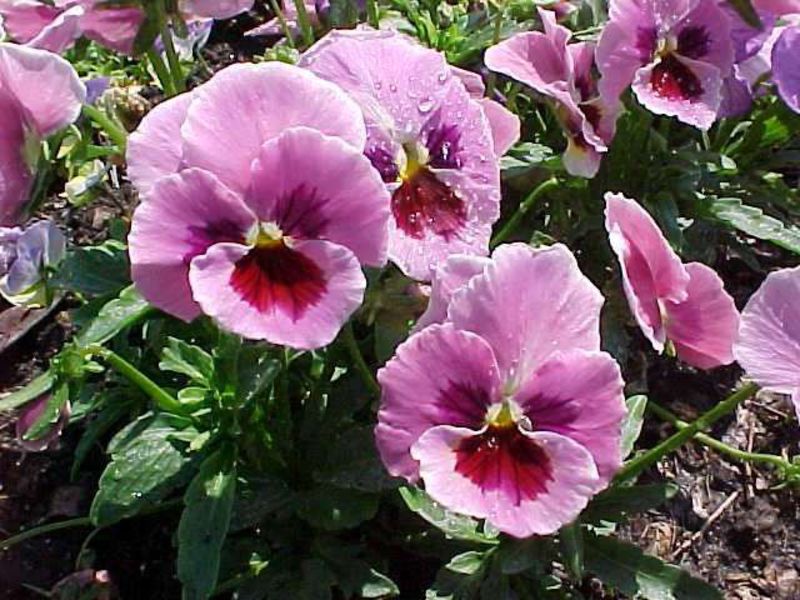
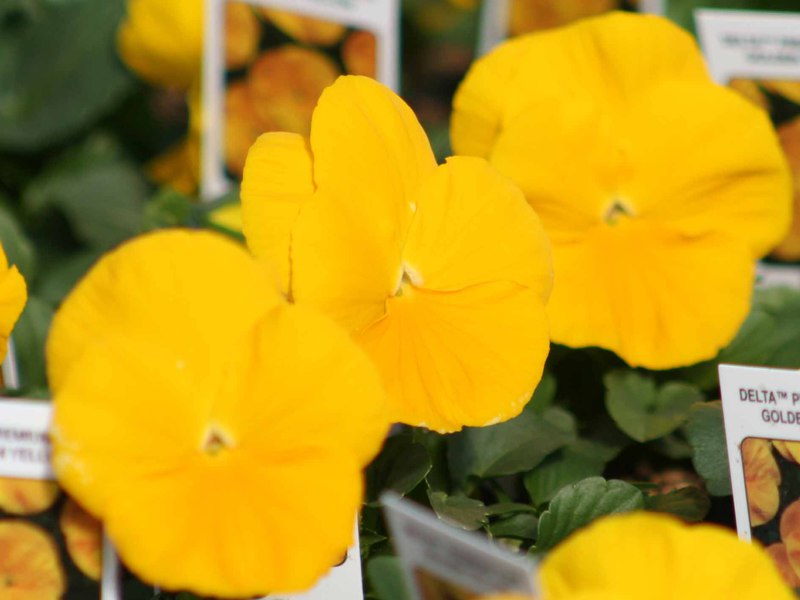

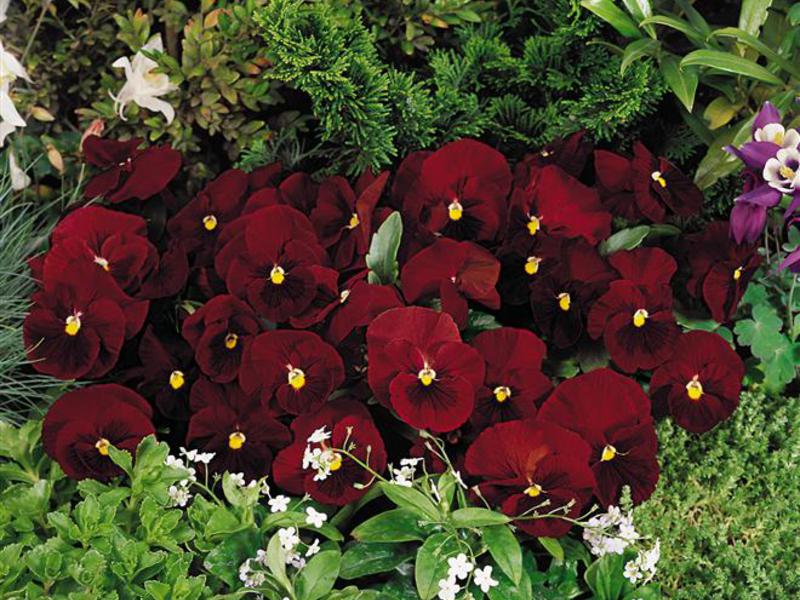
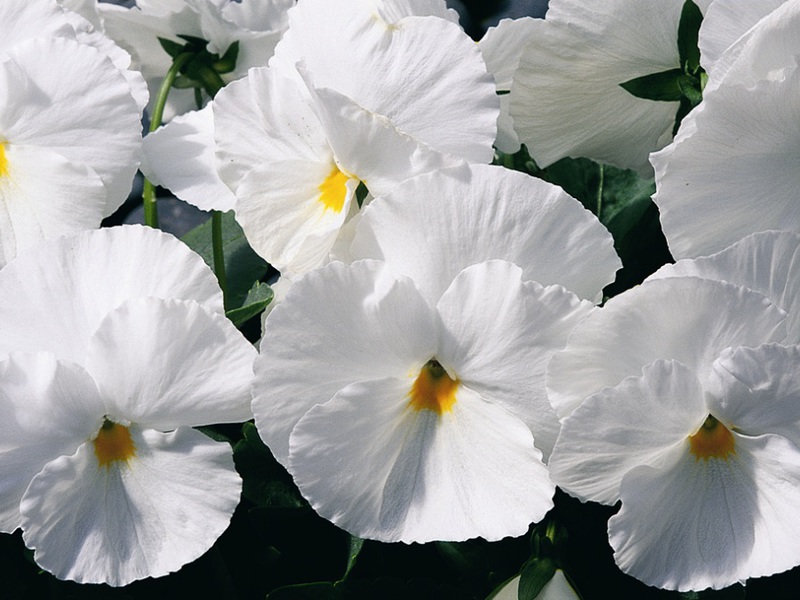
Types and varieties
The variety of garden violets includes more than 500 species and 1000 varieties. It is widespread and used both at home for the interior of rooms and for creating landscape design.
Below we will consider the main popular types and varieties of Viols.
Small-flowered bushes, have blue and blue shades of buds, the diameter of which is about 3 cm.
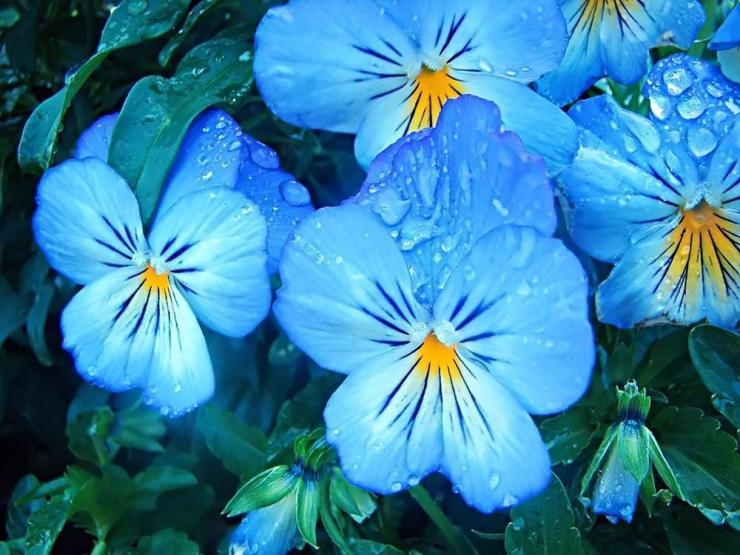
Small-flowered variety, has white single flowers with a diameter of 3 cm.
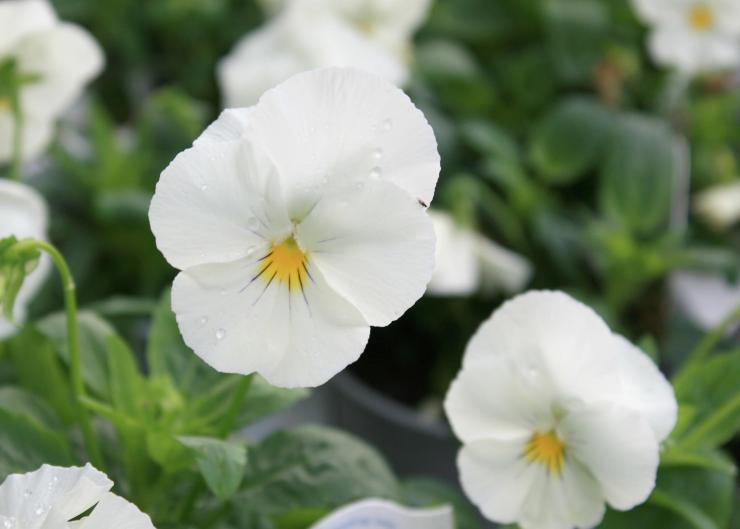
Small-flowered variety, strewn with bright red flowers with a diameter of 3-4 cm.
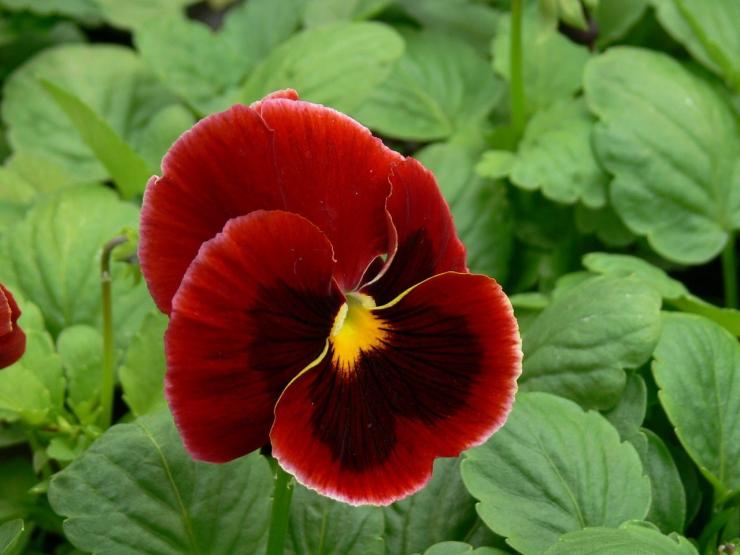
Ice king
Belongs to large-flowered varieties, the height of the bush is no more than 20 cm. It has beautiful white flowers with barely noticeable yellowish and greenish tints. The peduncle itself grows on a long stalk and reaches a diameter of more than 5 cm.
Heavenly queen
Low bush 20 cm high, with large varietal flowers.When blooming, the color reaches a pure blue, heavenly color, but when exposed to the sun, it fades and acquires pale lilac shades. Bud size 4-5 cm, the edges of the petals are even, the length of the leg is about 9 cm.
Winter sun
The bright orange flowers of this variety always attract attention. Have 3 lower petals with brown velvet spots and jagged edges
The leg is about 10 cm long, the bud itself has a diameter of 5 cm.
Jupiter
Low-growing shrub, belongs to two-year varieties. Velvet petals of a deep purple hue with a white rim, bloom at a time up to 20 pieces on one bush. It tolerates the winter season without problems.
Wittrock
The most popular hybrid species, which has exclusive double flowers in different shades. A branchy, densely growing bush reaches a height of 30 cm. The uniqueness lies in the abundant all summer flowering of buds from May to September. The flowers are large and irregular in shape. Absolutely resistant to cold climates.
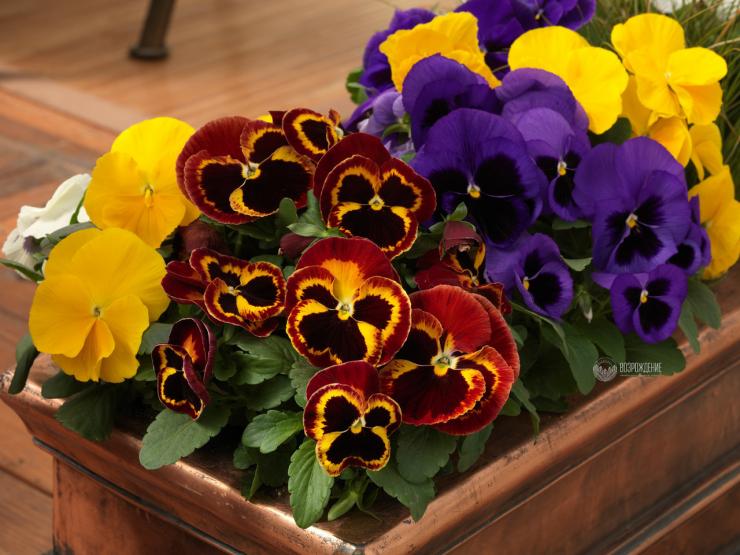
Horned
A perennial varietal violet that has been growing for many years in a row without losing its decorative effect. Its varieties have modest shades of lilac, violet and blue hues. Flowering is carried out in small buds 7 mm in diameter, with a standard yellow eye in the middle. It is used both as a pot and a curb decoration
Attention has the property of rapid cross-pollination with a number of growing Viola of a different variety.
Fragrant
A perennial variety of violets, has single buds of purple and white shades. Flowering time is in April, with cold conditions in May. Its uniqueness is hidden in an outgoing, enchanting scent that can be smelled by everyone nearby.
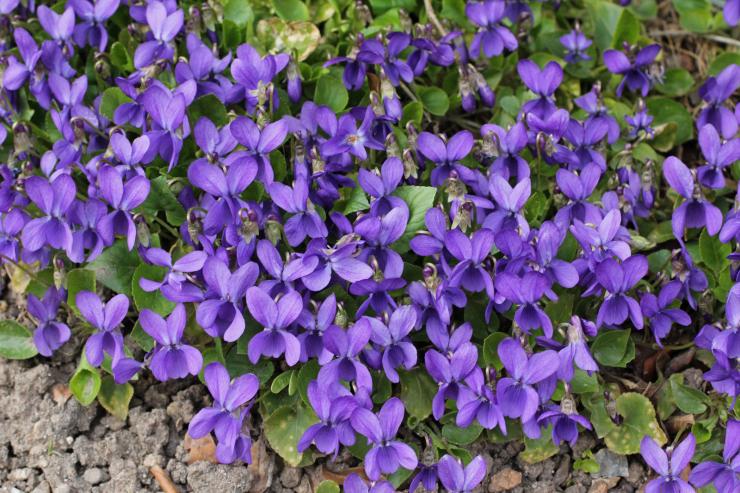
Moth
The varietal view of Viola, is a compact bush up to 20 cm in height, has beautiful single buds of purple hues. Flowering lasts 2-3 months from April to June.
Planting and growing viola at home
Viola is a wonderful decoration for any flower garden, having a huge range of colors and shapes. Often, the plant is planted in pots for a home garden, which can be planted on a balcony or windowsill.
Considering the fact that viola is a perennial violet that begins to bloom very early, you can enjoy the wonderful aroma and appearance of the plant when nature outside the window is just beginning to wake up. Planting a plant is not a particularly difficult and highly technical process, since this flower takes root quite well in virtually any conditions.
How to plant a flower with seeds and seedlings
This is a plant that is planted in two ways - seedling or seed. Cultivation from seeds can be carried out directly into the ground in the open air, by sowing, bypassing the steps for pre-germinating the seeds. It is planned to sow about fifty to sixty seeds on a one meter furrow. To do this, it is necessary to place the pits at a distance of about five centimeters from the previous ones, dropping three seeds into each. Before sowing, the seeds can be immersed for a while in a container filled with zircon or epin.
Seeds must be laid to a depth of half a centimeter, after which the filled holes are sprinkled with dry ground earth, and then lightly watered with water. It is advisable to sprinkle the surface with sawdust in order to maintain soil moisture for a longer time. A week later, the first shoots will begin to break through, which it is desirable to tighten with a film on top, thereby protecting the young shoots from external influences. The darkening material can be removed after three weeks.
Growing seedlings is just as easy at home, observing the minimum technology for caring for young seedlings. First, you need to prepare special pots of pressed peat, which should be immersed in water for a few minutes to saturate them with moisture. After soaking, seeds are immersed in pots, no more than three pieces in one container.After a week, the seedlings must be transferred to new soil, and after another three weeks, the pick is repeated. The seedlings will be ready to be transferred to open soil in one and a half to two months. In a permanent place of growth, seedlings should be at a distance of 25 centimeters from each other.
When to plant viola outdoors?
In order for the viola flowers to please and the next year, sowing should be resorted to at the end of summer (in July or August). Planting before winter involves mulching and in March the plant will delight the stunning beauty with blooming flowers.
If you want the flowers to start to delight in the first year after planting with their flowering, then you need to start growing seedlings in February in order to transplant the shoots into the soil by the end of March.
Proper care: watering and feeding
Due to the special structure and position of the root system of the flower, attention should be paid to caring for the plant, keeping the soil moist and loose. The fact is that the roots of the viola are at a depth of only 20 centimeters, for this reason it is necessary to water the plant from time to time.
However, in summer, if it is not dry, natural irrigation by means of rain will suffice.
You should also remove the weeds that appear near the plant during its growth. It is also necessary to pick off dried flowers with seeds in order for the viola to bloom to have maximum intensity and duration. The plant requires feeding once a month. Top dressing consists in treating the soil with ammonium nitrate or superphosphate - these fertilizers are calculated in the proportion of 30 grams per square meter of land.
Viola - varieties with names and photos
Wittrock
The undisputed leader! There are a huge number of varieties and hybrids, united in groups and series.
Some of them have not lost their popularity since the late 19th century. As an example: the Trimardo group.
- violet-blue Lord Beaconsfield with a snow-white "sail";
- blue Adonis (Adonis) with an "eye";
- dark red Cardinal also with "eye";
- coal Morenkenig (Mohrenkоnig).
Another historical group: Swiss giants and Quedlinburg giants. Popular:
- red Abendglut with a dark "eye";
- blue Alpensee with a dark center;
- blue-violet Bergvaht;
- golden Firnengold with a brownish "eye";
- white Firnenschne;
- apricot Orange Sonne;
- terracotta Flamme with a dark center.
F1 hybrids catalogs are updated annually. Interesting series - Terry lace, Ballerina and Rococo. Other:
- dwarf Crystal Bowl (Crystal Bowl);
- hardy Maxim;
- Giant Forerunner - with increased winter hardiness;
- spectacular Jolly Joker;
- early Spring Time;
- giant Super Majestic Giants, Majestic Giants and Magnum.
Horned
Highly sought after and fashionable, reminiscent of butterfly wings. In nature, it grows in harsh conditions. Expands rapidly to create a variegated, cushion-shaped carpet.
It owes its name to a spur on a petal that looks like a small horn. Low-growing - up to 30 cm.On a bush, up to 50 flowers with a diameter of 3-5 cm can form per season.
Breeders divide horned violets into 2 groups: Cornuta and V. Hybrida with a variety of variety series. Some in demand:
- Ruby and Red Charm - in shades of purple and red;
- Azure Wing, blooming from April until the very frost;
- creamy yellow Atona;
- profusely flowering Princess Krim;
- Yellow perfection;
- Orange perfection.
Fragrant
Officially introduced into horticultural culture since 1542. Early and abundant flowering. In a variety of shades: white, purple, violet, pink, purple and yellow. A perennial that reproduces well by self-seeding and vegetatively (creeping stems).
An excellent option for creating curtains in places that are difficult to access for full-fledged care. The aroma of a miniature bush growing 15 cm from the ground is barely perceptible.But in a spring bouquet - another matter!
- large-flowered Bechtles Ideal;
- pale white Christmas;
- pink-flowering Coeur d'Alsace;
- lilac and white Czar;
- Triumph - with very large flowers.
Tricolor
The same "tricolor" that gave the flower the famous name of pansy and is still used in breeding. Modern forms are quite interesting.
Modern viola is tricolor, grown as one, two, rarely perennial. Planting and caring for the plant is extremely simple
Viola ampelnaya - varieties with photos
The ampelous viola became the latest novelty of the selection. The purpose of the creation was to breed a plant with a habit that is ideal for hanging baskets, pots, balcony boxes. This is not some completely new species.
Ampelous are those forms of horned and Wittrock, the shape of the bush of which is as close as possible to spherical, and many flowers are formed on the bush.
Ampel forms growing in containers require special care:
- the presence of high quality soil;
- planting at the rate of 1-2 liters of land per plant;
- daily watering (moderate, and abundant in the heat);
- weekly feeding;
- regular removal of seed bolls.
Of the new ones:
- large-flowered Arkwright Ruby - red with a yellow spot and dark spots at the base of the lower petals;
- Pansy Freefall Lavender with a gentle cascade in cold tones;
- the most tender Cool Wave Frost;
- ampelous chic viola Pearl Waterfall, as well as Purple, Yellow, Black.
Today we talked about growing viola from seeds, when to plant a flower for seedlings and in the ground, and also how to care for it. We hope this information was useful to you. Bright flower beds to you!

